2
The Building Blocks of a Pitch Deck
The building blocks of a pitch deck are the slides. Slides are like the panels of a comic strip; they break down the story of your venture into discrete digestible chunks. Each slide highlights a different aspect of the venture and furthers the plot of the pitch. Eventually, you’ll have a whole archive of slides to draw from and sequence for each meeting or presentation. These are the essential ten (not including your cover page):
• Overview
• Opportunity
• Problem
• Solution
• Traction
• Customer or Market
• Competition
• Business Model
• Team
• Use of Funds
Cover
What should I expect?


What is it?
The cover slide captures the audience’s attention, sets the tone for the pitch, and serves as “white space” during a presentation so you can express gratitude for your audience’s time, show your passion for your venture, and build trust by mentioning mutual connections.
What should I demonstrate?
• Clean logo. Your logo is the face of your brand; it can be very important to your overall image.
• Inviting picture. You might include an engaging picture of your product or customer.
• Descriptive title. Put “Investor Briefing” or “Investor Presentation” somewhere on the front cover with the date. Dates help you keep track of different versions.
What questions do I need to answer?
• Does the cover make you want to open the pitch deck?
• Does the cover visual communicate what the product is or who it serves?
Overview
Who are we?
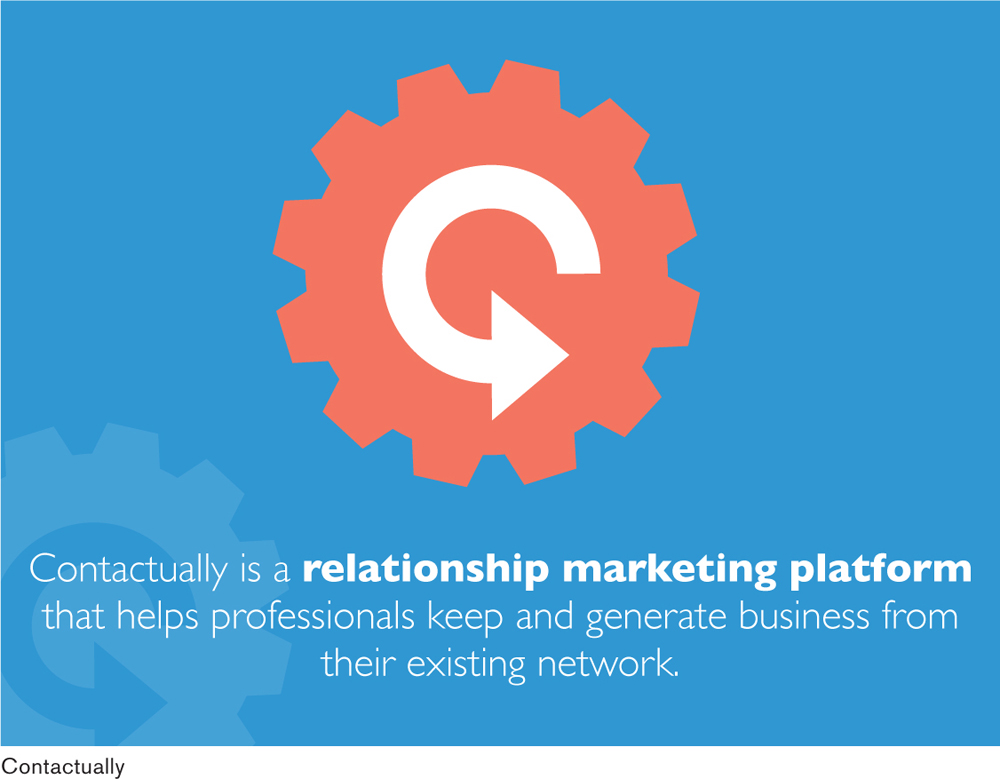
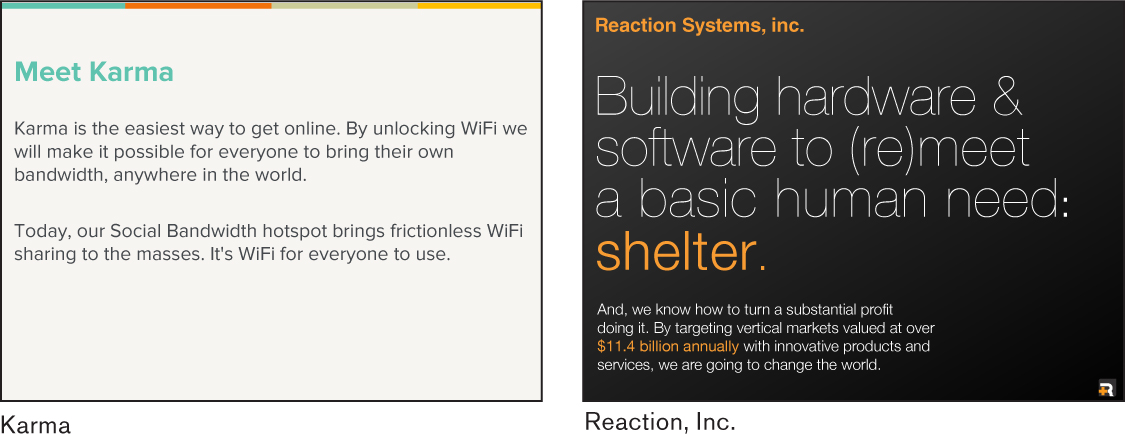
What is it?
The company overview is your “elevator pitch”—the fifteen-second version of your deck. It describes a problem you see in the world and how you are going to solve it. Give your audience a small taste of what your company does, but leave them hungry for more.
What should I demonstrate?
• Clarity. It should be extremely easy to understand what the company does.
• Swagger. Startups are bold, audacious undertakings. Your summary of the venture should demonstrate that you have the energy and the confidence to take on something big.
• Passion. If you don’t care about what you’re doing, no one else will.
What questions do I need to answer?
• What exactly does your company do?
• What industry are you in?
• Is this a novel idea?
DEEP DIVE
Opportunity
What’s happening in this market? Why now?
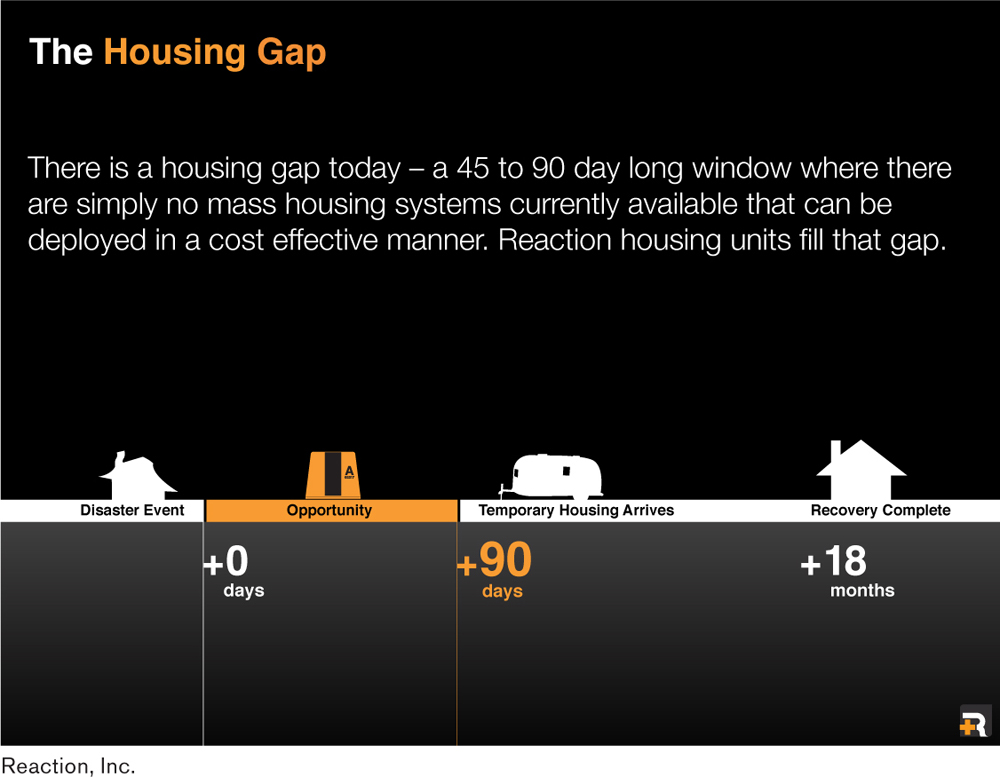
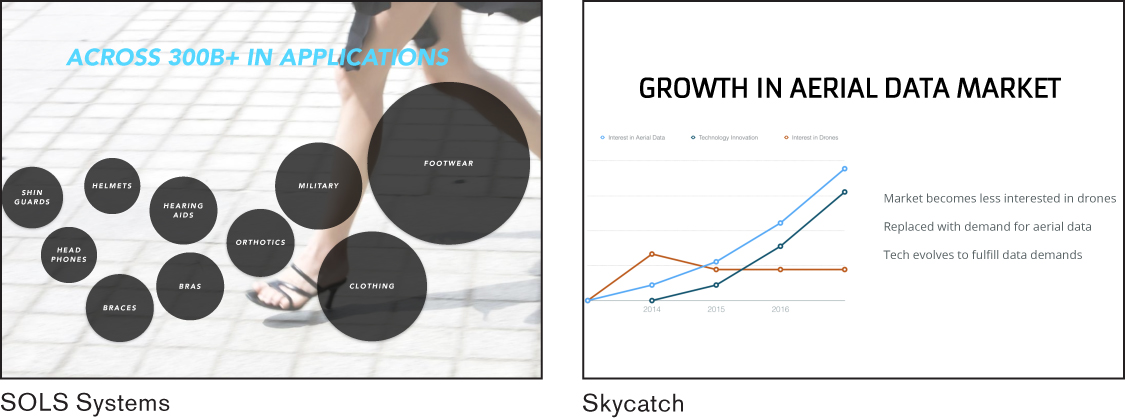
What is it?
The opportunity slide is your chance to describe your industry and how your business will work within it. You will describe trends within that environment, the size of your market, and the growth potential of your venture.
The opportunity slide is the 40,000-foot picture of your product’s space. You want the investors to see the trends and market conditions that will give you an entrance into the market and a competitive position. If your audience agrees with you on how things actually are right now, they will be open to the particular problems and solution you describe.
What should I demonstrate?
• Explosive market sectors. By explosive, we mean growing very, very fast. The faster your market is growing, the bigger the opportunity for your venture will be.
• Confusion and ambiguity in the market. A lack of clarity allows ventures to easily differentiate themselves from others.
• Thoroughness. This slide is proof that you have done some serious research and really understand the market better than your audience does.
What questions do I need to answer?
• What trends is your company riding?
• How big is the market?
• How big can your company be?
• What are the macro- and micro-trends that your company will be riding?
Problem
What are you trying to solve?

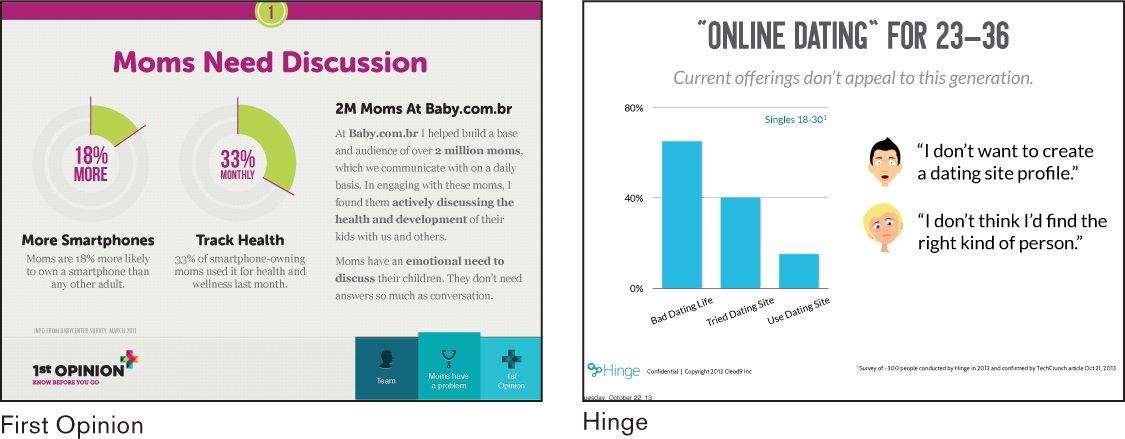
What is it?
Entrepreneurship, at its core, is about solving problems. The bigger the problem, the better.
In your problem slide, describe the problem you are solving and how and why that problem is painful. Your audience should feel as if an injustice has been done. In a meeting, you’ll know if your problem hits home when the investors begin nodding their heads in agreement. Describe the problem at a high level first and then quickly transition to a specific story of a customer to make the problem personal. People don’t empathize with big, general problems; they empathize with the struggles of specific people with names and faces.
Not all companies solve new problems; some focus on solving age-old problems in a way that changes customer preferences. This is especially true in apparel, restaurants, and many consumer product goods. If you have one of these ventures, you should focus on the opportunity before you (the previous slide) rather than the problem you are trying to solve.
What should I demonstrate?
• A big problem in a big market. Provide a very large and specific number of people who feel the pain of this problem every day.
• Deep understanding. Confidently and empathetically display how well you understand the complex market dynamics surrounding the problem.
• A specific person. Consider presenting the problem by telling a short story of a real person and how he experiences the problem.
What questions do I need to answer?
• What is the problem?
• How big is the problem?
• Why does the problem exist?
• How is the problem currently being addressed?
Solution
What are you doing about it?

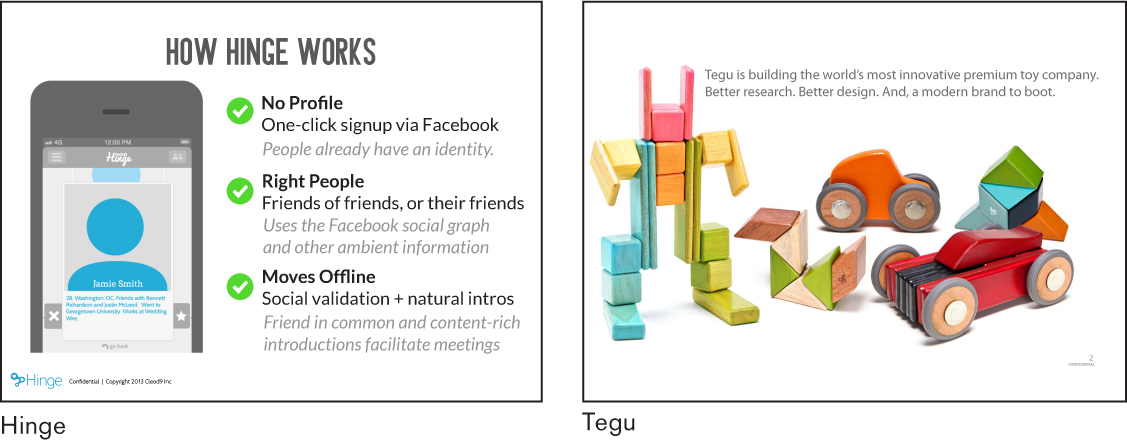
What is it?
By this point, you and your audience agree on what is happening in the industry and you have introduced a huge problem. Now, it is time to pull out all the stops. Show them your magic, your one-of-a-kind solution to the problem. You want the investors to marvel at it. You can also remind them how you can defend what you are doing through intellectual property claims. Develop use cases to demonstrate how your customer will be delighted with your solution.
Make your solution as realistic and interactive as possible. In meetings, bring the physical product or do an interactive demonstration. Short (one- to three-minute) videos, illustrations, screenshots, pictures, prototypes, samples, sketches, or demos are all great ways to show rather than tell your solution.
If you learn nothing from this book, remember this: never use bullet points for your solution slide!
What should I demonstrate?
• Beauty. There should be an element of elegance to your solution. It should feel like the way things should be.
• Surprise. Your solution should feel like nothing your audience has ever seen.
• Repeatable and scalable. It should be evident in your solution that what you are building can be replicated across the market.
• Solving something painful. It should be clear that your solution relieves a persistant pain point the customer currently experiences.
• Team excellence. This is your chance to brag and show off that you have an awesome team that has built something that delights.
What questions do I need to answer?
• Does it solve the customer’s problems like magic?
• Is the customer going to crave this product?
• What will the customer’s life be like once the problem is solved?
• How are you going to pull this off?
• Is it awesome?
Traction
What evidence do you have that shows this will be successful?


What is it?
The goal of this slide is to demonstrate that each of your assumptions about the venture is proving true and you are making significant progress. The most common way to show traction is through growing sales or users—one with the “hockey-stick” graph—but you can also focus on other key metrics you have identified. Investors don’t want to feel that a venture needs them. Traction helps convince an investor that the idea is going to be a success no matter what. If you are preproduct and don’t have any meaningful milestones or metrics to display, you can use this slide as an opportunity to illustrate your sales and marketing strategy.
What should I demonstrate?
• A pattern of fast-growing momentum.
• Clarity around what you are measuring and why it matters.
• A clear sales process you use to attract, educate, qualify, close, and provide after-sale service for your customers.
What questions do I need to answer?
• Is there massive growth?
• Where are the venture’s assumptions proving true?
• What is the strategy to reach and close more customers?
Customer or Market
Who are your customers—and how many of them are out there?
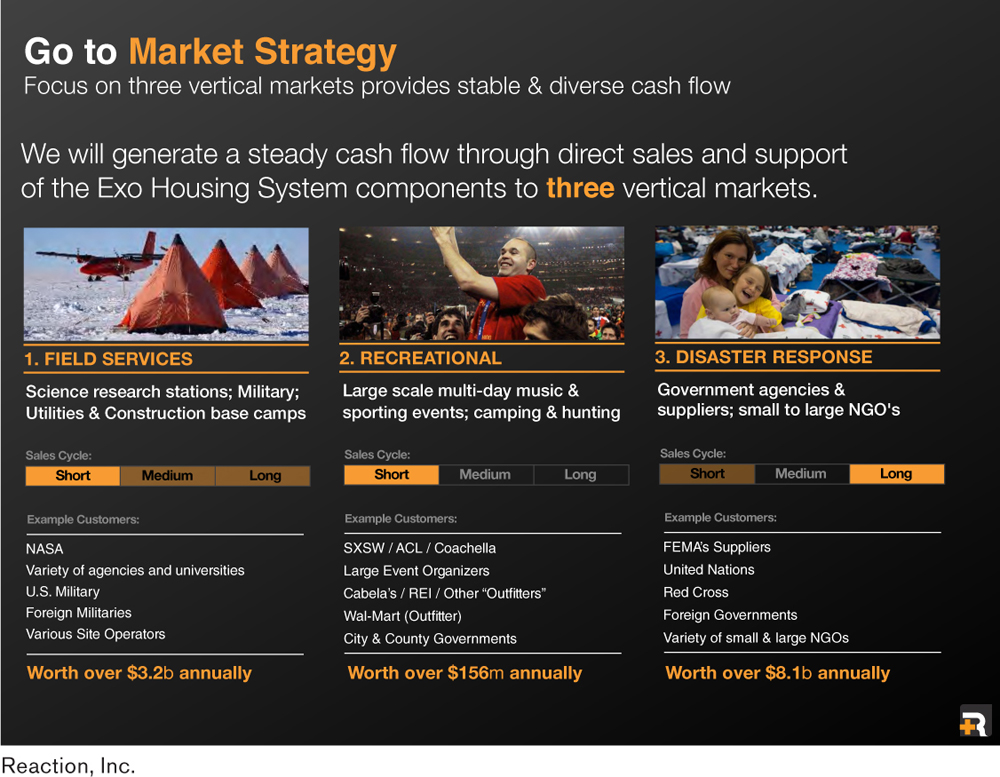
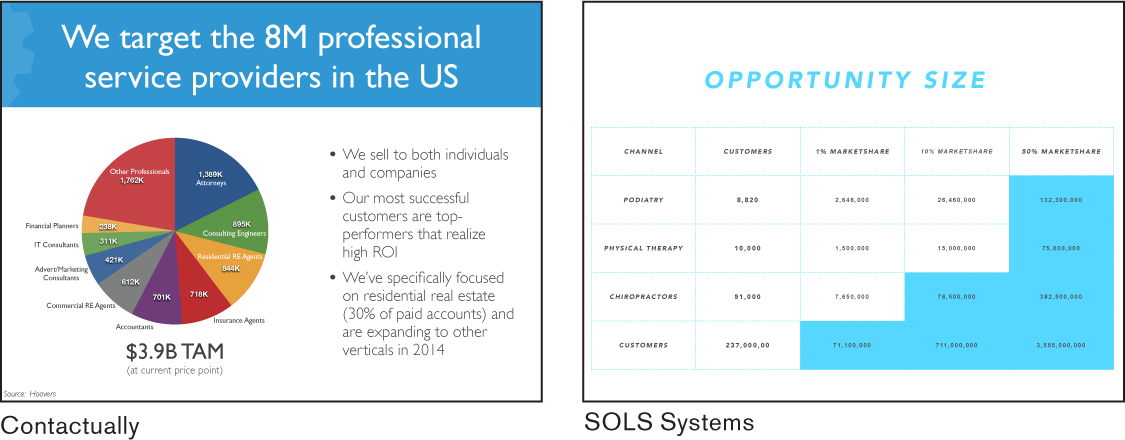
What is it?
In this slide, you demonstrate how well you know your customers and the market they represent. Describe where they live, what they like to do, and how much they’d be willing to spend. If you already have sales, you can use those as an example. Also describe the market, that is, how many potential customers are out there who will want to buy your product.
What should I demonstrate?
• The customer. Describe the person in a way that reminds listeners of someone they know.
• A clearly defined market. Give specific numbers for how many people fit your customer descriptions. Include how many people might possibly buy your product, what percentage of those people you expect to buy it, and which ones you will target first.
• Revenue. It’s much easier to argue that there’s a demand for your product if you have paying customers.
What questions do I need to answer?
• Who is your customer(s)?
• How will you reach the customer?
• What is the acquisition cost per customer?
• Is your customer willing to pay for your product or service?
DEEP DIVE
Competition
Who or what will steal your customers?
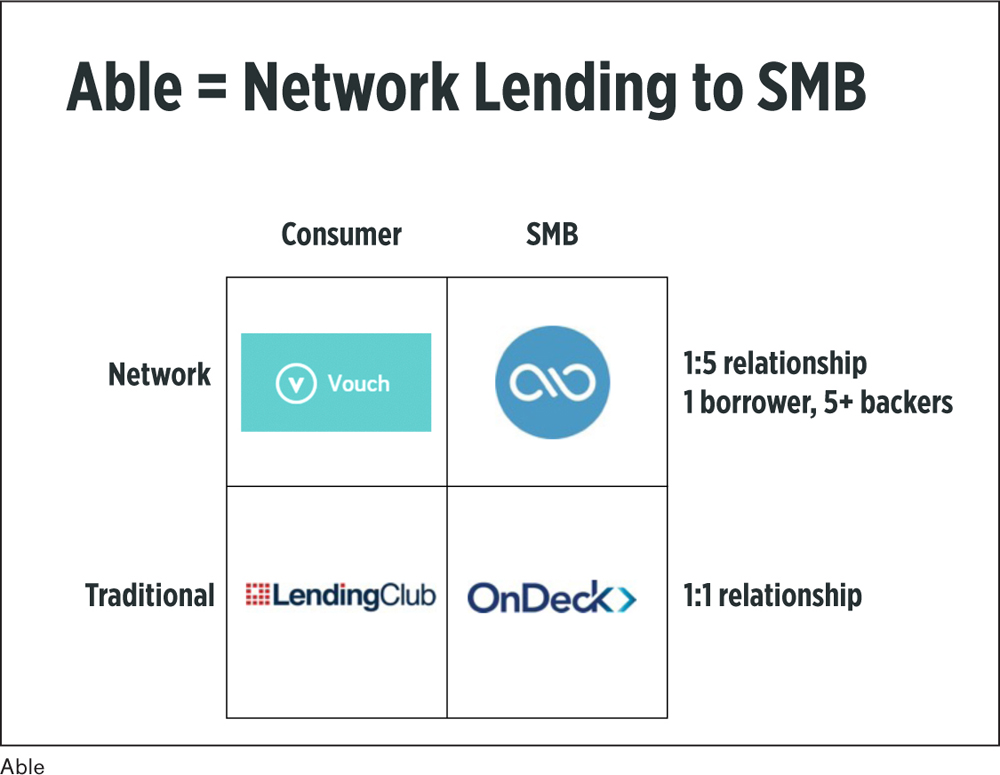
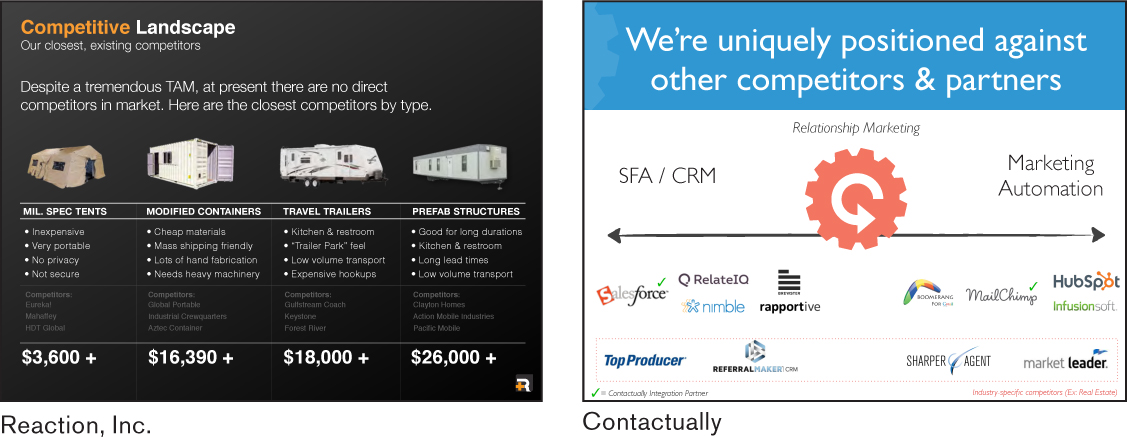
What is it?
Every venture has competition. Every venture.
Your customers must be doing something right now to cope with the problem you solve. That “something” is your competitor.
List competitors and describe how each competes in the market. Then, show what differentiates you from competitors and what advantage you have over them. Partnerships, technology expertise, intellectual property, simplicity, business processes, and networks can all be significant advantages. Many founders find it helpful to create a map of the competitive landscape, using important aspects of the product as x and y axes. For example, if you have a product that is both priced affordably and is a great value, you could put “cost” on the x axis and “value” on the y axis and place your product in the top-left quadrant (high value, low cost), with the rest of your competitors spread throughout the other quadrants. By doing this, you visually demonstrate how your product differentiates itself from other players in the market.
What should I demonstrate?
• Industry knowledge. You should know your competitors and their unique advantages and disadvantages.
• Sober judgment. Entrepreneurs caught up in the brilliance of their own ideas might miss major warning signs. An investor wants to know whether or not you are underestimating the threat of competition.
• Differentiation. Is it clear that you are different enough to compete?
• Unique advantage. What is your specific advantage over your competitors?
What questions do I need to answer?
• Who are your primary and secondary competitors and in what ways do they compete for your customers?
• Are there any unknown or potential competitors that would have a better advantage than you if they entered the market?
• Do you displace commonly used companies?
• How will you disrupt the current competitive landscape?
• Are you faster, cheaper, better?
• Why won’t an incumbent rip your product off and roll it out faster than you can?
Business Model
How will you make moneny?
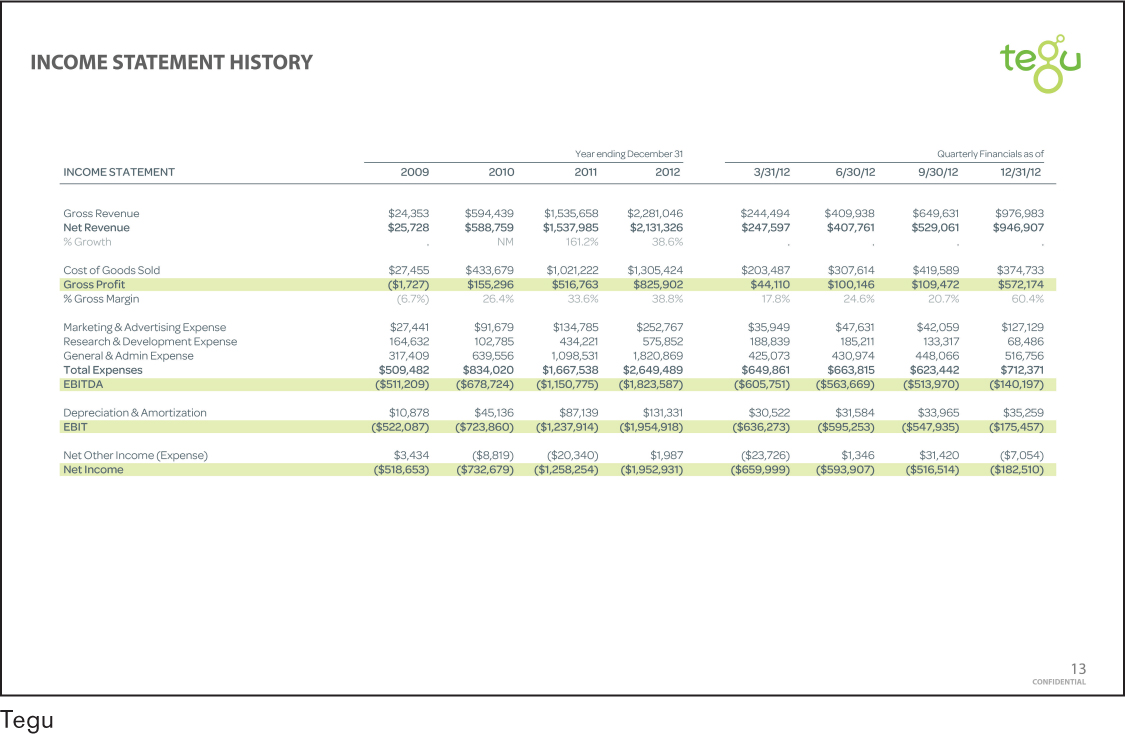
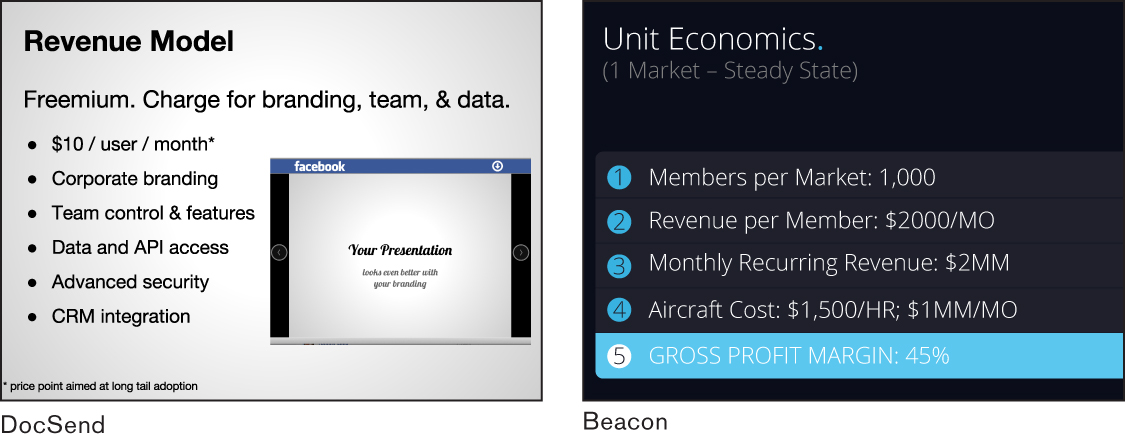
What is it?
Don’t worry; showing how the business makes money is much simpler than you think.
For example, a solid financial model will answer the following questions:
1. How much does it cost to acquire a customer?
2. How much cash will you make from that customer, over the course of their lifetime with you?
3. How do your costs break down, per unit and on a monthly basis?
Prerevenue companies may have the good fortune of making up assumptions and financials, but that is not an excuse for having unrealistic projections. Since the pitch deck is designed to introduce the idea, it’s not too important to show a full-blown financial model with every assumption, sensitivity, and margin analysis. However, it should include the important aspects such as revenue, gross profit, earnings before interest, taxes, depreciation, and amortization (EBITDA), net income, burn rate, and cash flow. Equally as important is to contextualize your math (as in, “if we get 1 percent of the market, then we will have hit our revenue projection”).
What should I demonstrate?
• Consistency. There should be a clear relationship between how costs and revenues grow over time.
• Financial literacy. You know how to think about the financials of a startup.
• Level-headedness. You are not overly optimistic about your projections or too cautious.
What questions do I need to answer?
• Can you acquire customers for less than a third of their lifetime value?
• What is your monthly burn rate—how much money are you spending a month?
• Are the revenue projections reasonable?
• Are costs legitimate?
DEEP DIVE
Team
Who is going to pull this off?

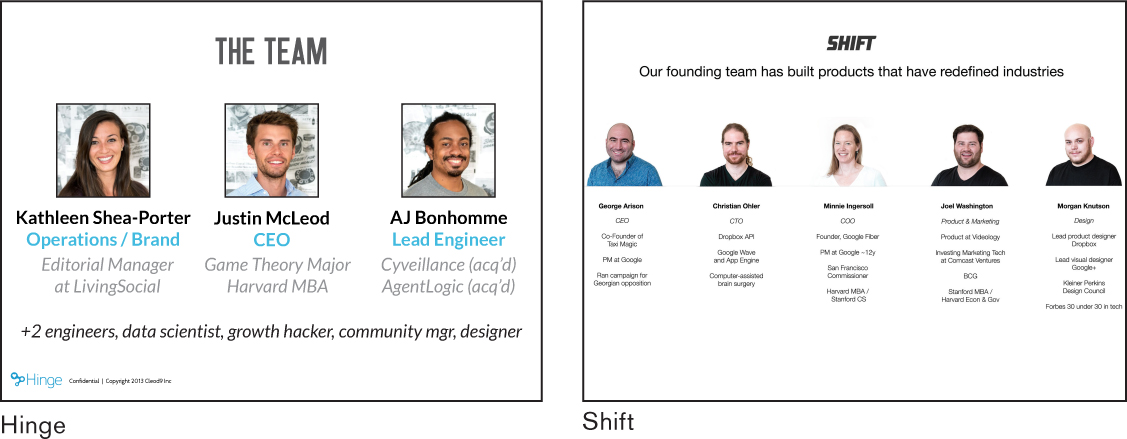
What is it?
In the team slide, you want to give the background for each of the key team members, including their current roles, prior experience, significant accomplishments, and education. If there are any major investors or advisers, you can name them here. Keep your bio to less than a minute total when presenting. Your goals are to build rapport, be known, and build confidence that the team can accomplish the mission.
What should I demonstrate?
• Brevity. Each bio should be only seventy-five words or less.*
• Domain expertise. You have the experience and insight to get the job done.
• Passion, intensity, and a good team culture. You know the kind of team culture you are creating and that each person is committed to it.
What questions do I need to answer?
• Why are you the right people for the job?
• Is this team sufficient to accomplish the goal?
• Are there others who need to be hired?
Use of Funds
What do you want and why?
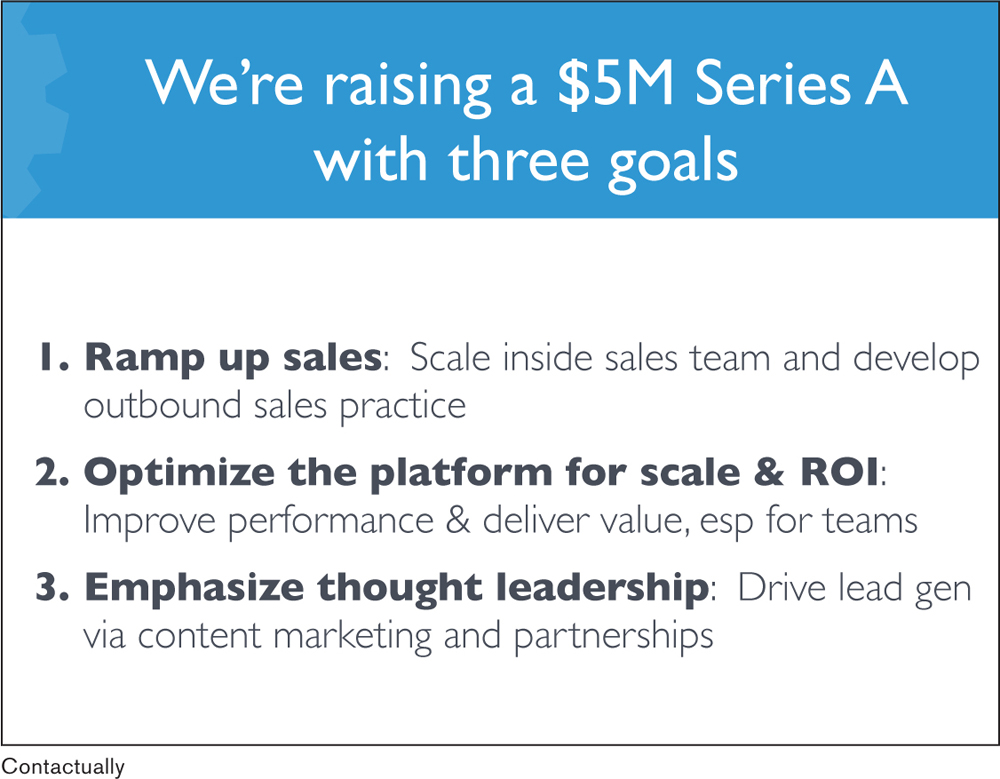
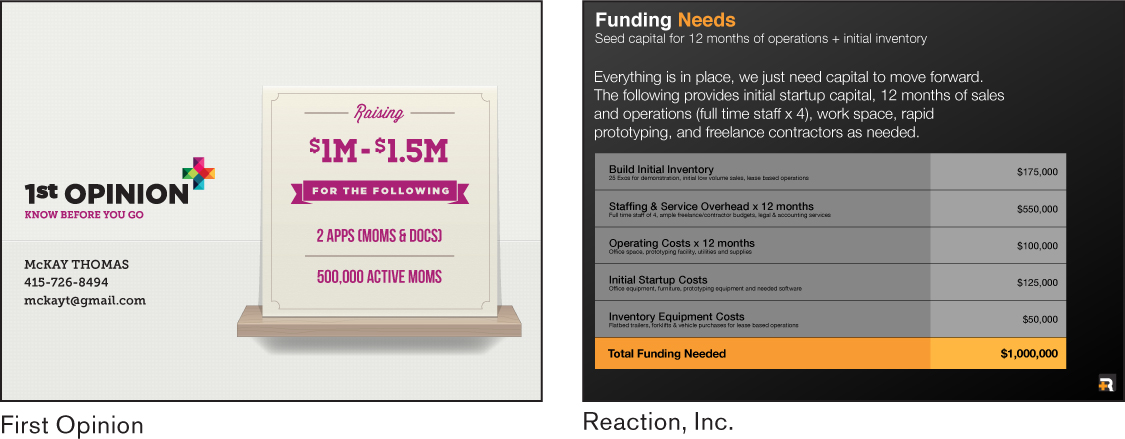
What is it?
A good pitch deck has a clear ask of the investor. This is married with an understanding of what the investor gets in return and what the money will be used for. Some entrepreneurs like to create a slide with every way the company can be sold, potential acquisition targets, initial public offerings, yada yada. Everyone will tell you something different, but we think it’s best to focus on your company. Spell out how you actually plan to use the money you are asking for. What will it give you in terms of resources or achieved milestones?
What should I demonstrate?
• Clarity. You specifically and clearly state what the funds will be used for.
• Milestones. You should show what you expect to achieve by the time the money is gone.
What questions do I need to answer?
• What size and type of investment are you looking for?
• How will you spend it?
• What will you accomplish with it?
• Who else is likely to be participating in this investment round?
Extra Slides
Although the ten building blocks make up the core of most decks, there are an almost infinite number of slides you might add, depending on your venture and the way you tell your story. Here’s a list of forty-one other slides to build into your deck or add to an appendix.
1. Frequently asked questions (FAQs). Usually, there are about five to ten questions that almost everyone asks. Build trust with investors by facing the difficult questions head on. Create a slide and put the questions and answers next to each other.
2. History. Context can be helpful. A history slide, typically laid out as a timeline, gives you the ability to show your company’s key mile markers, for example, incorporation, team formed, first product sold, money raised, and record sales month.
3. Products. Simply show your product(s). Make the product the hero of the slide: large, front and center, with little or no text around it.
4. Market. The market slide can show anything you want about the market you operate in. Characteristics like where the market is heading, how large it is, the changes taking place are important to lay out.
5. Patents. Patents can add value to your company. If you have them, show them. Patents are a clear demonstration that you can defend your venture from copycats.
6. People you are learning from. Few entrepreneurs include this slide; it’s one of our favorites. List everyone you are learning from: advisers, friends, investors, and so on. They can be people you know personally or whose work you follow and admire. The list shows you are curious and are sourcing a wide range of feedback from key people.
7. Executive summary. This simple overview of the venture and its opportunity usually consists of one or two sentences, placed in the middle of the slide.
8. Income statement, balance sheet statement, and cash flow statement. This trio makes up what people usually mean when they say “financials.” The later the stage of the venture, the more important these elements become.
9. Investment highlights. List well-known and respected investors who have already invested in the business, as well as previous successful funding rounds.
10. Milestones achieved. This timeline of important achievements shows that your team knows how to get stuff done. If you haven’t released your product yet, milestones are a great way to demonstrate momentum.
11. Branding. Consumer-facing and product-based startups often live and die by the experience they create for their customer. If the physical experience of your product matters, this slide gives you a chance to show that off.
12. Product road map. Investors want to know where you are headed next. What’s most important in the next three, six, and twelve months? A product road map, usually displayed through a timeline or Gantt chart, gives your audience a full picture of the long-term vision of the product and your priorities.
13. Mission. A mission statement should be actionable and personal. It answers the question: Why do we exist? The mission statement should help your team make better decisions and gives others insight into what’s driving the venture.
14. Vision. Vision statements are aspirational; they describe the kind of world you are striving to create. The goal of this slide is to get others to buy into your vision of the future.
15. Pictures. This really isn’t a slide type, but a storytelling technique. Using a picture with few or no words can help immerse your audience into a scene or experience that you want them to understand.
16. Supply chain. This diagram traces where and how you source your raw materials and inputs for your product. A solid and protected supply chain can be a hedge against competition and an unfair advantage over existing players or new entrants.
17. How it works. Quickly explain to your audience how your product does what you say it does.
18. Risks. This slide lists the biggest challenges you face as a venture. Examples of risks include assumptions you’ve made that you have to prove or industry dynamics that make you vulnerable. This slide explains that you understand exactly what those risks are and what you are doing to defend against them.
19. Differentiation. If you are in what others may consider to be a crowded market, this slide explains what makes you different.
20. Locations. Show a current map of where your customers are or where your product is available.
21. Geographic growth plans. This future-oriented version of the “locations” slide shows where you plan to be over the next several months.
22. Screenshots. Screenshots of your product are a simple way to show your audience exactly what you are doing and lets them experience your product as a customer would.
23. Sales funnel. This diagram demonstrates how you are systematically getting customers. A typical funnel moves through a process of gathering leads, qualifying those leads, educating potential customers and answering objections, closing, and then following up with after-sales service. Investors like to know how you are moving people through each stage in the process and what the conversion rates are from one stage to the next.
24. Customer acquisition strategy. This slide is a different way of showing the same thing as the sales funnel: how you plan to get customers. Be specific on this slide. E-mail marketing campaigns, Google AdWords and Facebook ads, influencer or ambassador programs, referral programs, trade shows, and cold-pitching are all examples of potential acquisition strategies. In addition to showing the strategy, give data on the expected costs and conversion rates of these strategies.
25. Customer lifetime value. How much will each customer be worth over the course of his or her engagement with your product? Show this number and how you arrived at it (how many times do they purchase over what period of time?).
26. Designs/blueprints. Similar to the “how it works” slide, this gives you a chance to demonstrate the underlying mechanics of a product.
27. History and background. Tell the backstory of your team and the venture that led to where you are today. This slide can help you demonstrate expertise and previous success in your space.
28. Unique value proposition. Popularized by tools like the Business Model Canvas and Lean Canvas, this slide presents a clear statement of what makes you different and why customers will buy your product.
29. Competitive or unfair advantage. What difficult-to-copy advantage do you have over competitors?
30. Pipeline. Depending on the size of each deal, this list of the customers that you are currently negotiating with shows the names and logos of well-known customers or calculates the total size of those deals in dollars to show likely future sales.
31. Strategic partnerships. This slide shows the names or logos of strategic partnerships that will help you get more customers, lower costs, or break into new markets.
32. Customer quotes. Customer quotes give others a more intimate picture of why people buy your product or service.
33. Comparable companies. This slide lists the companies in your space and key metrics.
34. Go-to-market strategy. Which customers do you plan to target first and how do you plan to target them? Include evidence for why this is the right first move to make.
35. Case study. Tell a story of a specific customer or partnership and how your product did amazing things for them.
36. Organization chart. This slide is a diagram of your current team, their titles, and who reports to whom. Show a typical organization chart in a hierarchical tree format.
37. Exit strategy. Explain your strategy for whether you plan to exit the business through acquisition, IPO, or something else, when you plan to exit. For acquisition exit strategy, include a list of potential acquirers.
38. Exits. List the companies that are similar to yours and have had successful exits. Include their valuations at the time of the exit.
39. Conclusion. This is the “sum it all up” slide—a clear statement that explains the power of your venture and the opportunity your audience has to be a part of it.
40. Technology. Describe and visualize the core technology that powers your product and keeps your venture from being copied by others.
41. Valuation. List the terms of the deal you are offering: how much you are raising and the valuation of the company. If you are structuring your raise with a convertible note, include the valuation cap and the discount you are offering.
Beyond Just Slides: Story, Design, and Text
In “The Building Blocks of a Pitch Deck,” we gave you a basic outline. Most entrepreneurs stop there. But over the next three chapters, we’re going to dig into the key elements that transform a deck from a lifeless document that fails to inspire into one of your biggest assets: story, design, and text. For perspective, you might spend 25 percent of your time on the architecture and the remaining 75 percent on these components that really differentiate your deck.
*You should also prepare a longer (250–500 word) bio, in case an investor asks for it. The point of the pitch deck bio is to get your audience’s attention, not tell your life story.
